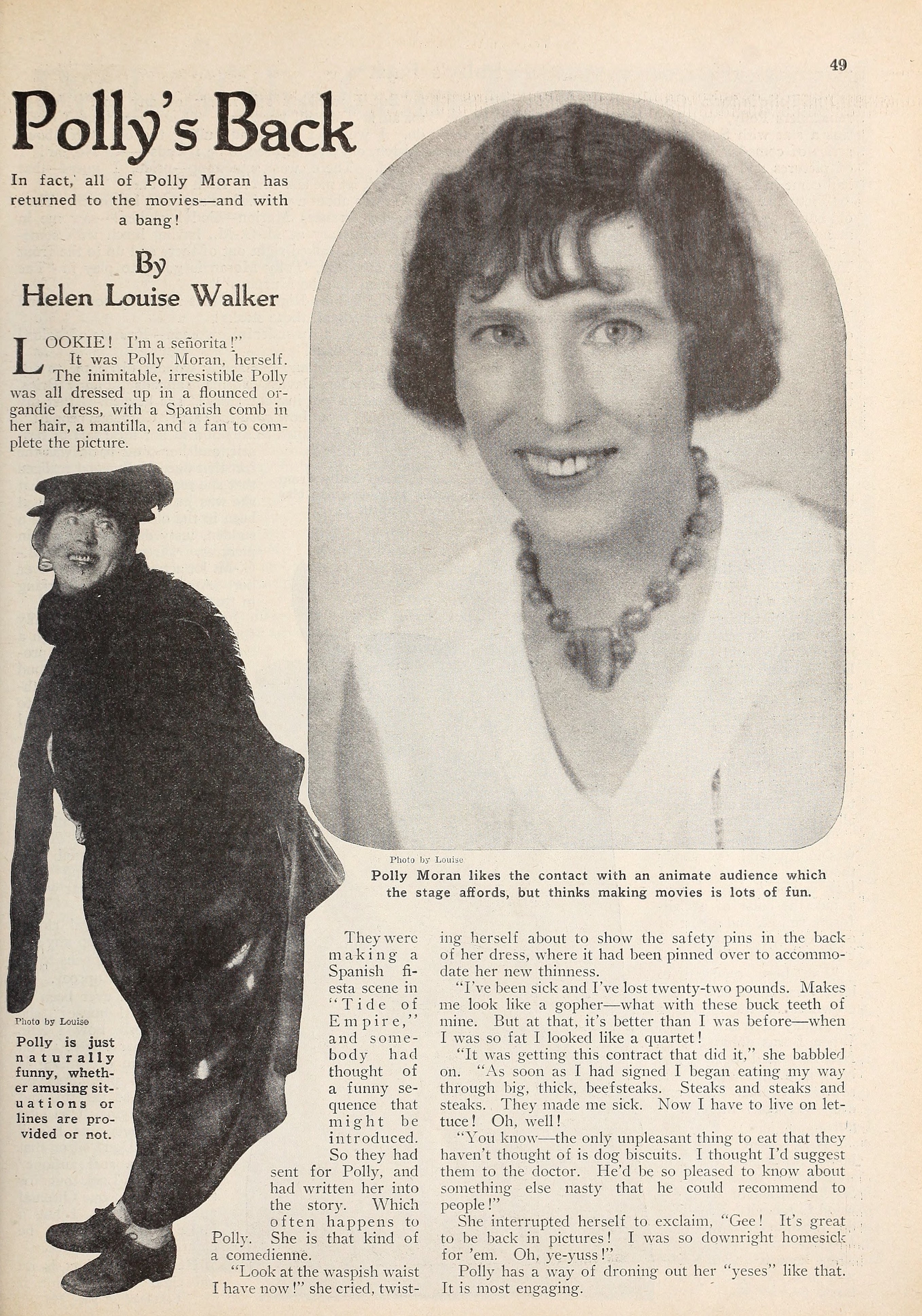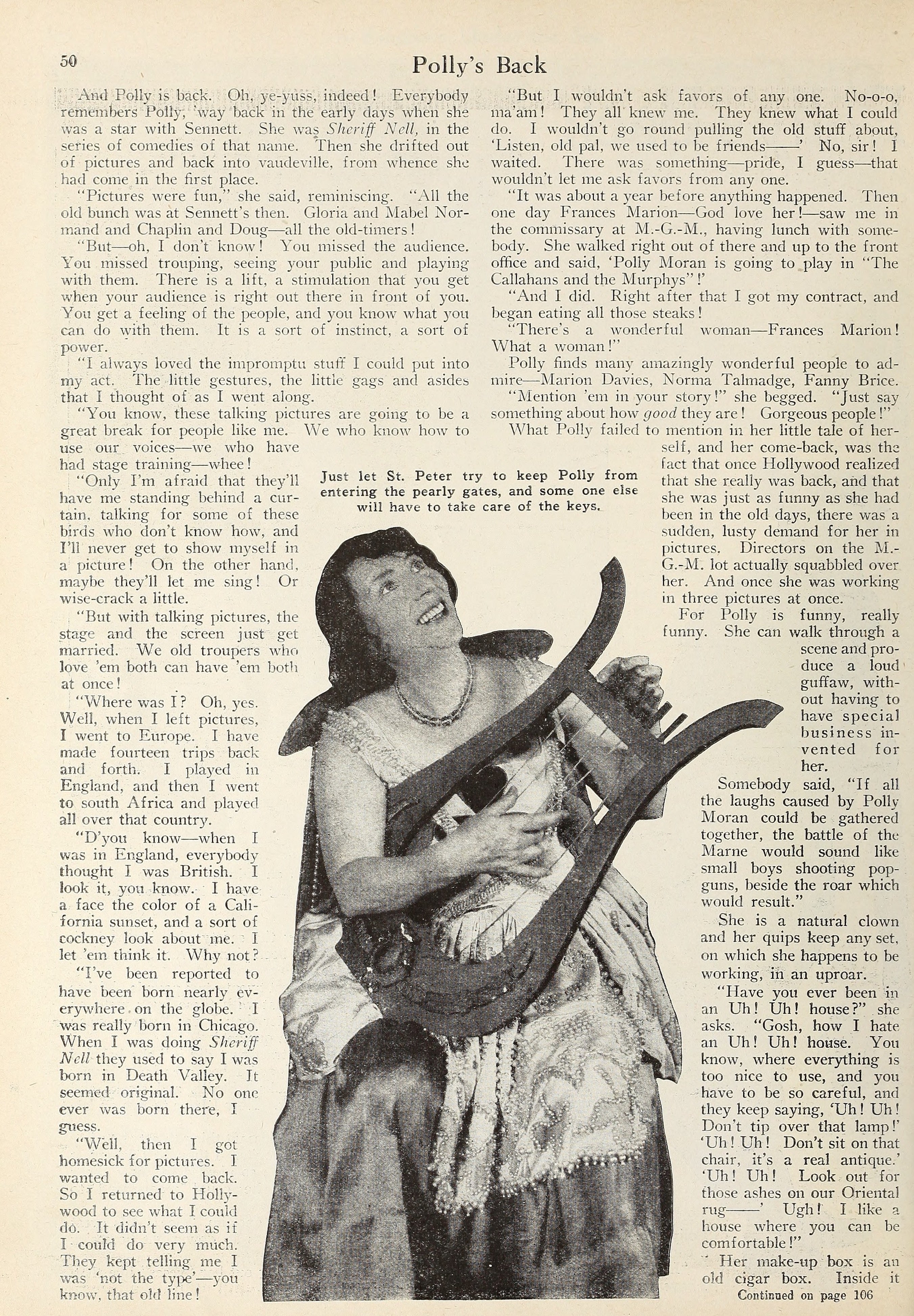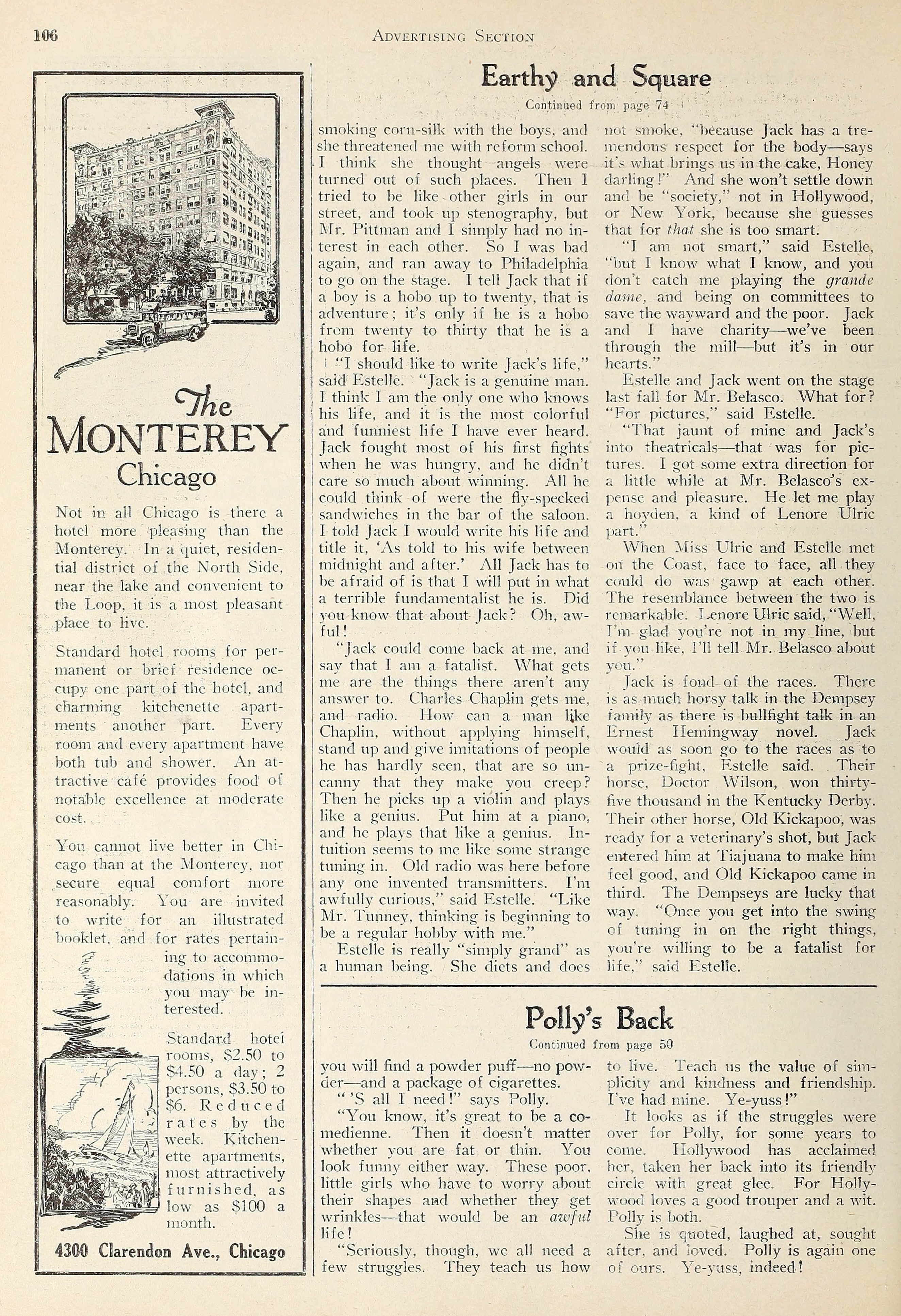Polly Moran — Polly’s Back (1929) 🇺🇸

“Lookie! I’m a señorita!” It was Polly Moran, herself. The inimitable, irresistible Polly was all dressed up in a flounced organdie dress, with a Spanish comb in her hair, a mantilla, and a fan to complete the picture.
by Helen Louise Walker
They were making a Spanish fiesta scene in Tide of Empire, and somebody had thought of a funny sequence that might be introduced. So they had sent for Polly, and had written her into the story. Which often happens to Polly. She is that kind of a comedienne.
“Look at the waspish waist I have now!” she cried, twisting herself about to show the safety pins in the back of her dress, where it had been pinned over to accommodate her new thinness.
“I’ve been sick and I’ve lost twenty-two pounds. Makes me look like a gopher — what with these buck teeth of mine. But at that, it’s better than I was before — when I was so fat I looked like a quartet!
“It was getting this contract that did it,” she babbled on. “As soon as I had signed I began eating my way through big, thick, beefsteaks. Steaks and steaks and steaks. They made me sick. Now I have to live on lettuce! Oh, well!
“You know — the only unpleasant thing to eat that they haven’t thought of is dog biscuits. I thought I’d suggest them to the doctor. He’d be so pleased to know about something else nasty that he could recommend to people!”
She interrupted herself to exclaim, “Gee! It’s great to be back in pictures! I was so downright homesick ‘for ‘em. Oh, ye-yuss!”
Polly has a way of droning out her “yeses” like that. It is most engaging.
And Polly is back. Oh, ye-yuss, indeed! Everybody remembers Polly, way back in the early days when she was a star with Sennett [Mack Sennett]. She was Sheriff Nell [for example in The Pullman Bride (1917)], in the series of comedies of that name. Then she drifted out of pictures and back into vaudeville, from whence she had come in the first place.
“Pictures were fun,” she said, reminiscing”. “All the old bunch was at Sennett’s then. Gloria [Gloria Swanson] and Mabel Normand and Chaplin [Charles Chaplin] and Doug [Douglas Fairbanks Sr.] — all the old-timers!
“But — oh, I don’t know! You missed the audience. You missed trouping, seeing your public and playing with them. There is a lift, a stimulation that you get when your audience is right out there in front of you. You get a feeling of the people, and you know what you can do with them. It is a sort of instinct, a sort of power.
“I always loved the impromptu stuff I could put into my act. The little gestures, the little gags and asides that I thought of as I went along.
“You know, these talking pictures are going to be a great break for people like me. We who know how to use our voices — we who have had stage training — whee!
“Only I’m afraid that they’ll have me standing behind a curtain, talking for some of these birds who don’t know how, and I’ll never get to show myself in a picture! On the other hand, maybe they’ll let me sing! Or wise-crack a little.
“But with talking pictures, the stage and the screen just get married. We old troupers who love ‘em both can have ‘em both at once!
“Where was I? Oh, yes. Well, when I left pictures, I went to Europe. I have made fourteen trips back and forth. I played in England, and then I went to south Africa and played all over that country.
“D’you know — when I was in England, everybody thought I was British. I look it, you know. I have a face the color of a California sunset, and a sort of cockney look about me. I let ‘em think it. Why not?
“I’ve been reported to have been born nearly everywhere, on the globe; I was really born in Chicago. When I was doing Sheriff Nell they used to say I was born in Death Valley. It seemed original. No one ever was born there, I guess.
“Well, then I got homesick for pictures. I wanted to come back. So I returned to Hollywood to see what I could do. It didn’t seem as if I could do very much. They kept telling me I was ‘not the type’ — you know, that old line!
“But I wouldn’t ask favors of any one. No-o-o, ma’am! They all knew me. They knew what I could do. I wouldn’t go round pulling the old stuff about, ‘Listen, old pal, we used to be friends —’ No, sir! I waited. There was something — pride, I guess — that wouldn’t let me ask favors from any one.
“It was about a year before anything happened. Then one day Frances Marion — God love her! — saw me in the commissary at M.-G.-M., having lunch with somebody. She walked right out of there and up to the front office and said, ‘Polly Moran is going to play in The Callahans and the Murphys!’
“And I did. Right after that I got my contract, and began eating all those steaks!
“There’s a wonderful woman — Frances Marion! What a woman!”
Polly finds many amazingly wonderful people to admire — Marion Davies, Norma Talmadge, Fanny Brice.
“Mention ‘em in your story!” she begged. “Just say something about how good they are! Gorgeous people!” What Polly failed to mention in her little tale of herself, and her come-back, was the fact that once Hollywood realized that she really was back, and that she was just as funny as she had been in the old days, there was a sudden, lusty demand for her in pictures. Directors on the M.G.-M. lot actually squabbled over her. And once she was working in three pictures at once.
For Polly is funny, really funny. She can walk through a scene and produce a loud guffaw, without having to have special business invented for her.
Somebody said, “If all the laughs caused by Polly Moran could be gathered together, the battle of the Marne would sound like small boys shooting popguns, beside the roar which would result.”
She is a natural clown and her quips keep any set, on which she happens to be working, in an uproar.
“Have you ever been in an Uh! Uh! house?” she asks. “Gosh, how I hate an Uh! Uh! house. You know, where everything is too nice to use, and you have to be so careful, and they keep saying, ‘Uh! Uh! Don’t tip over that lamp!’ ‘Uh! Uh! Don’t sit on that chair, it’s a real antique.’ ‘Uh! Uh! Look out for those ashes on our Oriental rug —’ Ugh! I like a house where you can be comfortable!”
Her make-up box is an old cigar box. Inside it you will find a powder puff — no powder — and a package of cigarettes.
“‘S all I need!” says Polly.
“You know, it’s great to be a comedienne. Then it doesn’t matter whether you are fat or thin. You look funny either way. These poor, little girls who have to worry about their shapes and whether they get wrinkles — that would be an awful life!
“Seriously, though, we all need a few struggles. They teach us how to live. Teach us the value of simplicity and kindness and friendship. I’ve had mine. Ye-yuss!”
It looks as if the struggles were over for Polly, for some years to come. Hollywood has acclaimed her, taken her back into its friendly circle with great glee. For Hollywood loves a good trouper and a wit. Polly is both.
She is quoted, laughed at, sought after, and loved. Polly is again one of ours. Ye-yuss, indeed!

Polly is just naturally funny, whether amusing situations or lines are provided or not.
Photo by: Ruth Harriet Louise (1903–1940)
Polly Moran likes the contact with an animate audience which the stage affords, but thinks making movies is lots of fun.
Photo by: Ruth Harriet Louise (1903–1940)

Just let St. Peter try to keep Polly from entering the pearly gates, and some one else will have to take care of the keys.

Collection: Picture Play Magazine, February 1929
---
see also Aren’t Women Funny? (1929)
